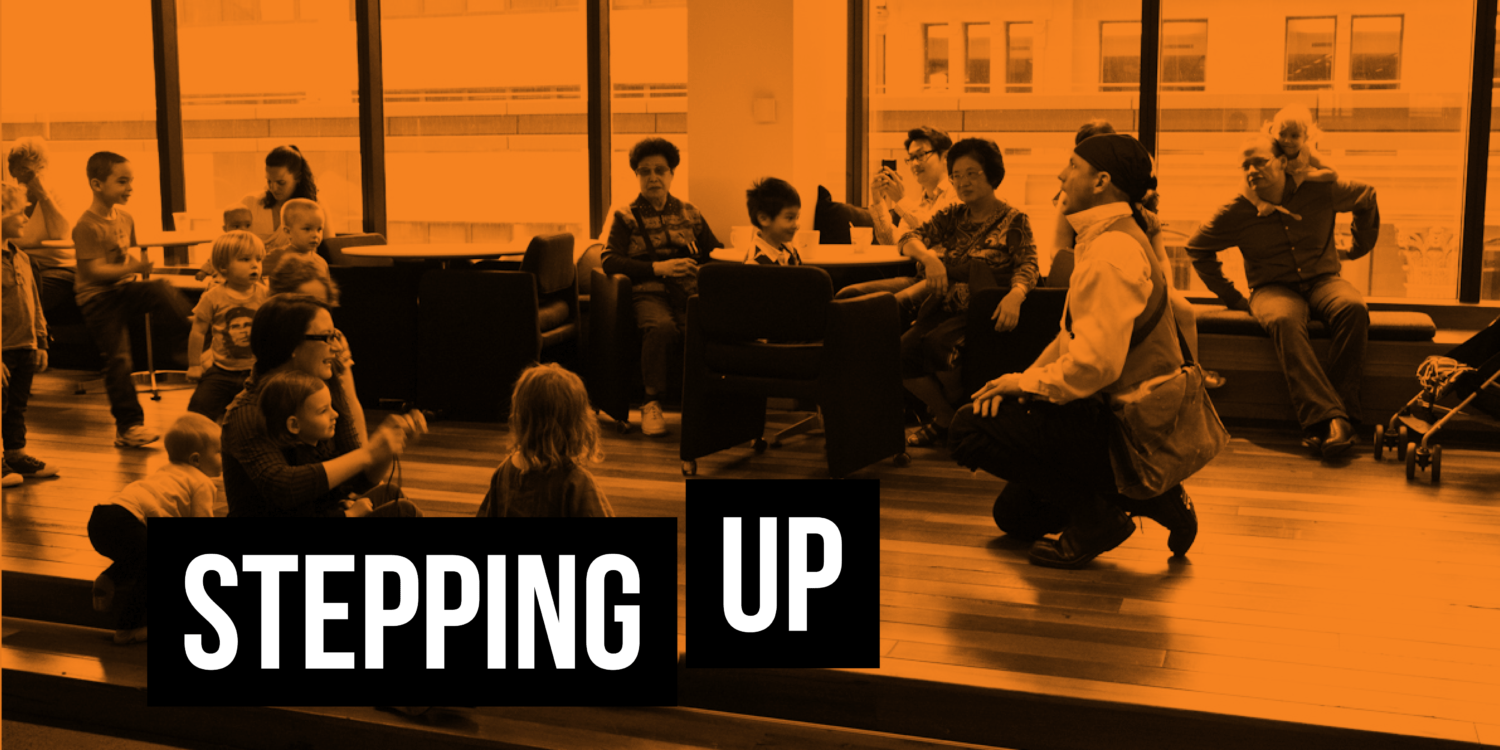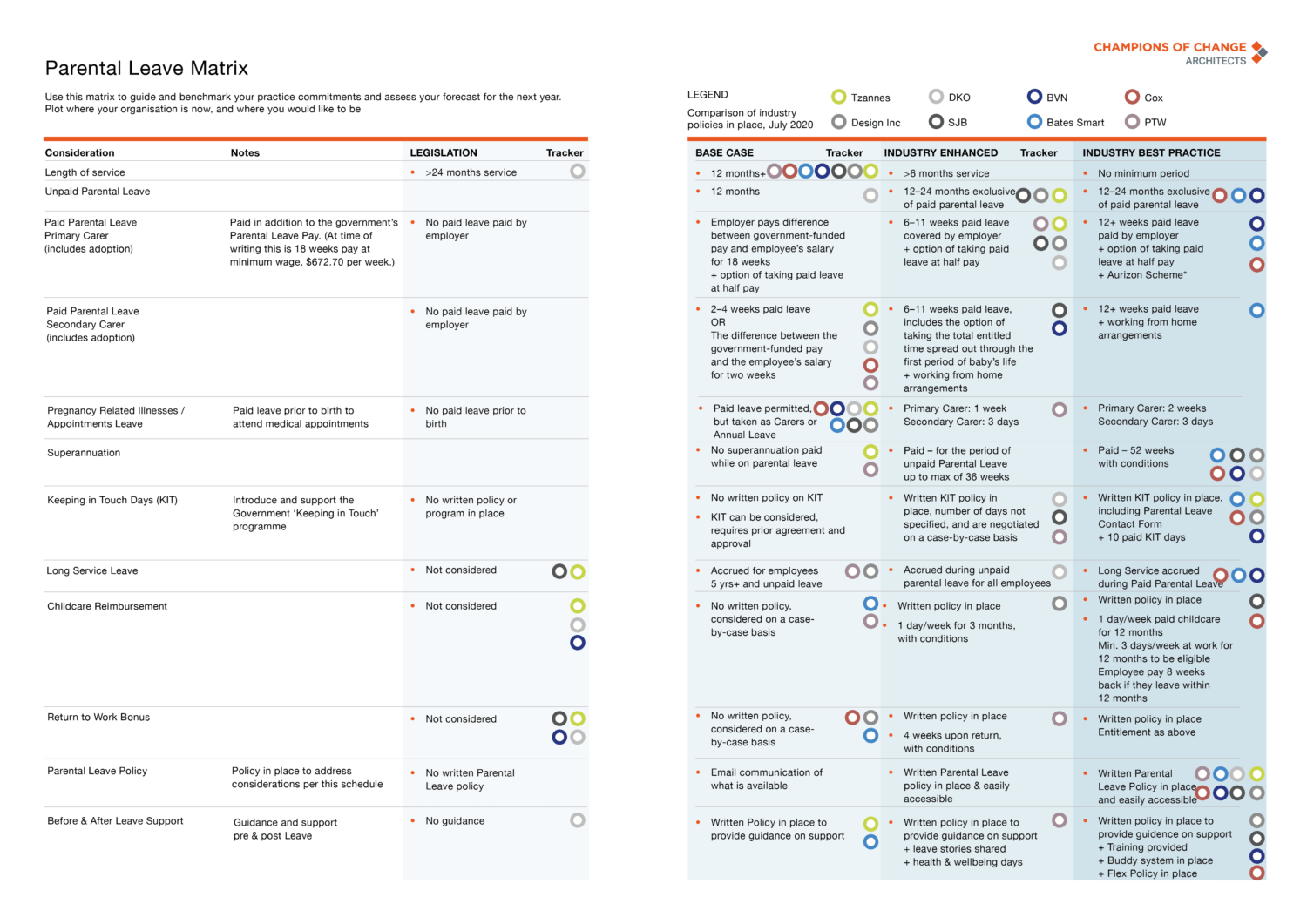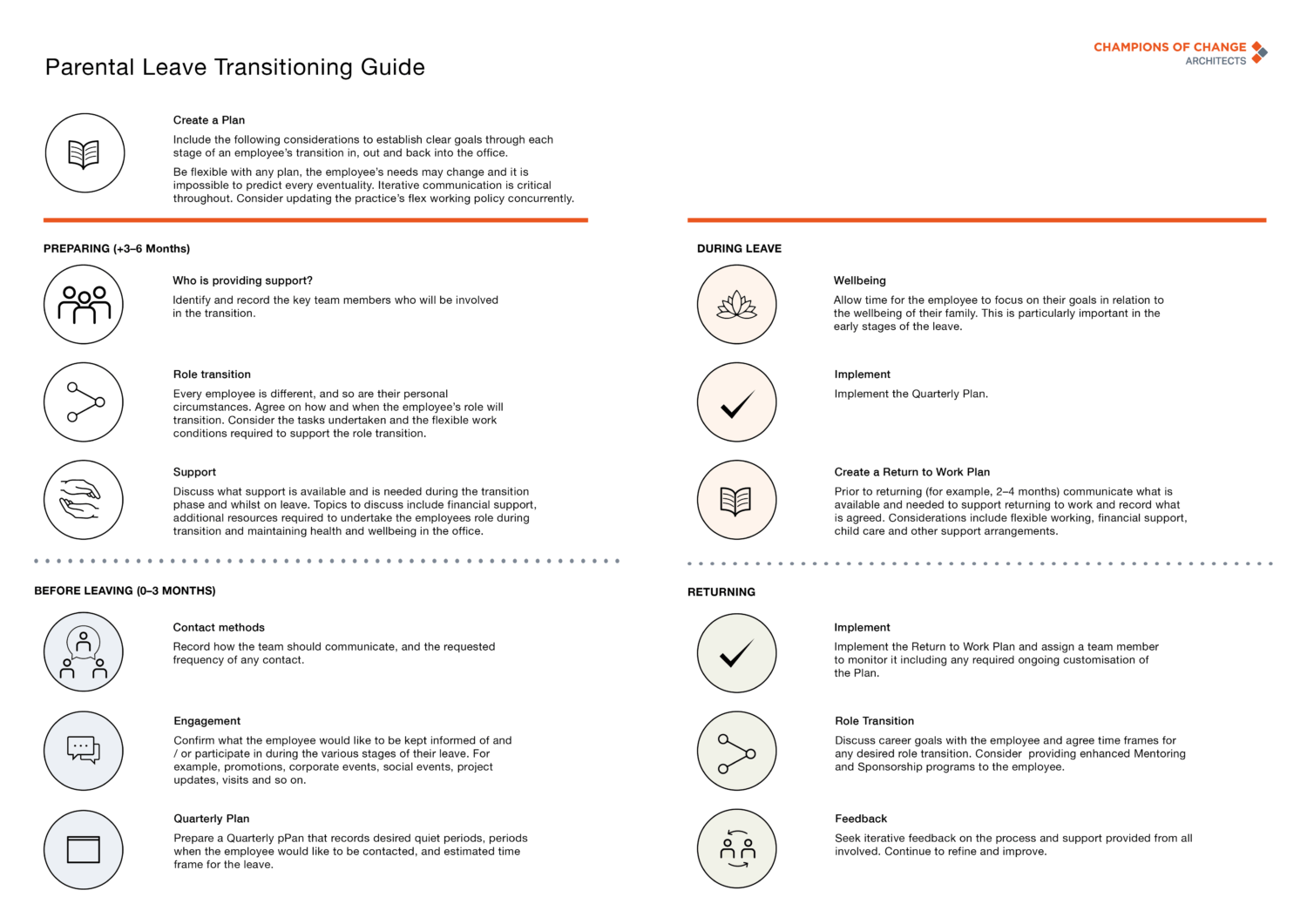A good Parental Leave Policy is essential to creating a workplace culture and policy environment that supports parents at all stages. This helps ensure that raising a family doesn’t derail or devalue the career of a talented and valued individual, while also enabling the practice to accrue long-term benefits from investing in staff training and development.

This article offers an approach to developing and implementing a parental leave policy. It is organised into five sections:
Developing a parental leave policy
The following steps will help develop and implement a robust parental leave policy – from understanding the content, to articulating ambitions to reviewing, testing and refining.
1
Review your practice profile, research best practice and develop the business case
Research industry standards and best practice
There is a substantial body of material available to support those developing Parental Leave policies. The other articles in this set are an excellent place to start, as is the Parlour Guide to Career Breaks. The Parental Leave Matrix below sets out options in four stages.
Understand minimum requirements under employment law
The Australian Government Parental Leave Pay (PLP) Scheme is based on the weekly rate of the National Minimum Wage. Primary carers can receive payment for up to 18 weeks, which is 90 payable days. This can be claimed for one set period (up to 12 weeks, or 60 payable days) plus one flexible period (including 30 Flexible Paid Parental Leave days). Eligible working dads and partners (including same-sex partners) get 2 weeks leave paid at the National Minimum Wage.
Survey staff to understand needs before, during and after leave
Understand what is currently occurring in your practice, and what people would like to happen.
Review the business case, calculate and assess financial position
Understand what your staff are looking for in mentoring. Ask them through listening and learning discussions as well as with a questionnaire – see the example below.Refer to the example Parental Leave Calculator, which outlines factors to include when assessing the financial implications of various options.
2
Commit to strategies
Create systems for before, during and after leave
Refer to the suggestions in the companion article, What is Parental Leave and Why does it Matter?
Develop and implement policy and procedures
Refer to the Parental Leave Matrix and the Components of a Parental Leave Policy below. Ensure that the policy and procedures integrate with the desired culture of the practice, and articulate well with other policies.
Agree on principles that frame the policy
3
Review and monitor the return-to-work transition
Successful implementation requires continuous monitoring and feedback from employees, managers and employers.
- Schedule regular catchups
- Ensure ongoing integration with career progression processes, mentoring, and flex working policy
4
Ongoing review and refinement
- Survey staff
- Review metrics
- Review policy and make any improvements
Parental Leave Matrix
The Parental Leave Matrix is a tool for assessing where the practice is, and identifying where it wants to be over time. It provides a staged outline of the components of a Parental Leave Policy – from the minimum of compliance with legal obligations to a Base Case and Industry Enhanced and Industry Best Practice options. It is useful both as a planning tool and a framework for discussion.
The image below shows where the Champions of Change practices where in 2020.

Parental Leave Calculator
The Parental Leave Calculator was developed to provide a measurable framework for practices to assess the cost and return on investment associated with parental leave entitlements. This was set up as a simple spreadsheet. The documentation below is offered as a model that could be tailored to suit the particulars of different practices.
Watch Chi Melhem talk through the Parental Leave Calculator example –– from the Light at the End of the Tunnel session on Parental Leave.

Components of a Parental Leave Policy
A Parental Leave Policy includes a range of components, which should be tailored to reflect the aspirations, values and business projections of the practice. This section offers an outline of key components and examples that can be used as the basis for practices to develop their own policy.
Principles
Establishing the principles that underpin the policy helps to guide its development and integrate it into the culture and wider policy framework of the practice. Principles provide an important framework for assessing the detail of a policy and its impact and implementation.
Sample Principles
The example offered below was developed by the Champions of Change Parental Leave Action Group. Each practice should tailor the principles to suit the particulars of their practice:
Commitment, Context & Definitions
A Parental Leave Policy should set out the commitment, employment context, eligibility and definitions.
Sample Commitment, Context & Definitions
The example offered below was developed by the Champions of Change Parental Leave Action Group. Each practice should tailor the information to suit the particulars of their practice:
Our Commitment
[Insert company name] is dedicated to best practice parental leave and will continually evaluate this policy to ensure that raising a family does not derail or devalue the career of a talented and valued member of this company.
An employee may take parental leave associated with the birth of their child (or their partner’s child) or the placement of a child under adoption, if the employee will have responsibility for the care of that child.
Employment Standards
[Insert company name] will continually evaluate and assess this policy in accordance to applicable legislation:
Fair Work Ombudsman https://www.fairwork.gov.au/leave/maternity-and-parental-leave
Eligibility
Parental Leave provisions apply to all full-time and part-time employees who have at least 12 months employment with [insert business name] before the expected date of birth or adoption.
Definitions
In this policy, ‘partner’ means an employee’s spouse or de facto partner (or former spouse or de facto partner). An employee’s de facto partner means another person, whether of the same or different sex as the employee, with whom the employee lives in a relationship as a couple on a genuine domestic basis.
In the case of adoption-related leave, the child being adopted must be aged under 16 years on the day of placement, and must not have lived continuously with the employee for 6 months or more prior to the date of placement.
Primary Carer means a person who has the primary care of a newborn or newly adopted child, and meets the child’s physical needs more than anyone else. Only one person can be a child’s Primary Carer at any given time.
Secondary Carer means a person who has parental responsibility for a child but who is not the Primary Carer.
Entitlements
A Parental Leave Policy should set out the entitlements of those taking the leave. Use the Parental Leave Matrix to select the options best suited to your organisation and insert them into the model offered below. Delete any that are not applicable.
Sample entitlements
The example offered below was developed by the Champions of Change Parental Leave Action Group. Each practice should tailor the entitlements to suit the particulars of their practice:
Primary Carer Leave
- 12 weeks leave paid at full pay, or 24 weeks paid at half pay;
- A further period of unpaid Parental Leave, where the total Parental Leave taken by an employee does not exceed 52 weeks (subject to an approved extension).
To be eligible, you must be the Primary Carer of the child and have not already taken Secondary Carer’s Leave for the same child.
An employee may take parental leave associated with the birth of their child (or their partner’s child) or the placement of a child under adoption, if the employee will have responsibility for the care of that child.
Secondary Carer Leave
- 12 weeks leave paid at full pay, or 24 weeks paid at half pay;
- The period of leave must be taken for a minimum of one week, which can be taken concurrently with your Spouse or De facto Partner’s Parental Leave.
To be eligible, you must be the Secondary Carer of the child and have not already taken Primary Carer’s Leave for the same child.
Special Parental Leave
- Where the pregnancy of an employee terminates after 20 weeks other than by the birth of a living child, the employee may take Special Parental Leave on full pay for such periods as a registered medical practitioner considers necessary, up to a maximum of two weeks. If you have any accrued paid personal/carer’s leave, you may take that leave upon completion of Special Parental Leave.
Unpaid Parental Leave
- 12–24 months exclusive of Paid Parental Leave.
Superannuation
- Paid for the period of unpaid Parental Leave up to max 52 weeks.
Long Service Leave
- Long Service accrued during unpaid Parental Leave.
Keeping in Touch Days
- [Insert business name] may arrange with the employee up to 10 days’ paid work to encourage employees on parental leave to stay connected with their workplace and transition back to work. Employees will be entitled to payment at heir normal rate.
Childcare Reimbursement
- 8 weeks upon return within 12 months for senior staff.
To be eligible, an employee must return to work minimum 3 days/week for 12 months. Employees that leave within 12 months are to pay 8 weeks back.
Return to Work Bonus
- 8 weeks upon return within 12 months for senior staff.
To be eligible, an employee must return to work minimum 3 days/week for 12 months. Employees that leave within 12 months are to pay 8 weeks back.
Procedure
A Parental Leave Policy should set out the procedures for applying for leave as well as the processes of staying in touch during leave and arranging to return to work.
Sample Procedure
The example offered below was developed by the Champions of Change Parental Leave Action Group. Each practice should tailor the procedures to suit the particulars of their practice:
Before Leave
Applying for Parental Leave
- Discuss with your HR/practice manager and director
- At least 8 weeks before the intended date of commencement of parental leave, complete a leave request form and provide to HR Manager to confirm the start and end dates and a Statutory Declaration
- [Insert business name] may direct an employee to start unpaid parental leave if the employee is pregnant and there is a risk caused to them by their work, or ifthey are incapable of work due to a pregnancy-related illness
Health and Wellbeing Leave
- For pregnancy related appointments or illness, refer to Flexible Working Policy
During Leave
Keeping in Touch Days
- Discuss with HR/practice manager and director
- Complete a Parental Leave Contact Form
- Confirm Frequency of KIT days and review regularly
Varying the Parental Leave Period
- Employee may request to extend their parental leave by a further period of up to 12 months.
- Provide a written notice specifying the new end date for the leave at least 4 weeks before the original end date.
Return to Work
End of Leave
- [Insert business name] will contact you 8 weeks prior to begin planning for your
- transition back to work.
- You may request to return to work under a flexible work arrangement. Refer to Flexible Working Policy for procedures.
Parental Leave Transitioning Guide
This infographic provides an easy to share guide for the key considerations when transitioning in and out and then back into work.

For more on introducing a Parental Leave policy, see What is Parental Leave and Why Does it Matter?
This article was compiled by Justine Clark as part of a set that draws on the Parental Leave Toolkit, created by the Champions of Change Architecture Group. Valuable assistance was given by Monica Edwards and Susanne Jensen of the Champions of Change Architecture Group Advocacy and Comms Focus Group.
Contributors to the CoC Parental Leave Toolkit include Thihoa Gill (Grimshaw), Gemma MacDonald (DKO), Amy Lyden (Nettleton Tribe), Laura Saunders (DKO), Jason Embley (Grimshaw), Nicole Allen (Grimshaw), R. Johnston (Peddle Thorp), Yi-han Cao (Tzannes), Karyn Dodman (Tzannes), Tara Keast (DesignInc), Dave Tordoff (Hayball), Sandeep Amin (at the time DesignInc) and Chi Melhem (at the time Tzannes).
Stepping Up is a collaboration between Parlour, the ACA and the Champions of Change Architecture group.




















